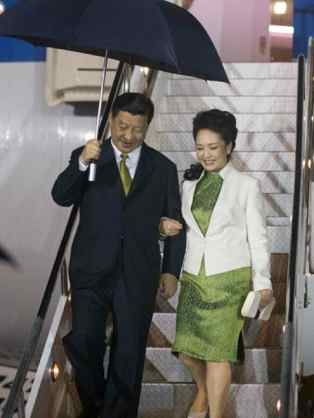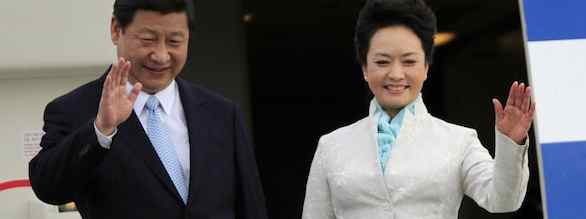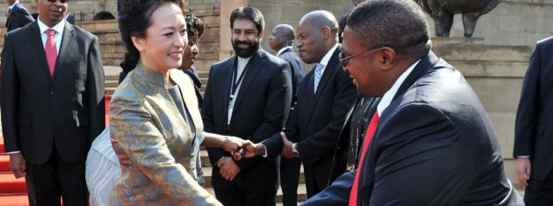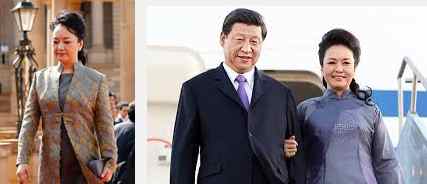When China’s new president Xi Jinping walked down the airplane stairs in the tiny Carribean nation of Trinidad and Tobago in June, it was a shimmering moment in Chinese modern history. Not only was he arm in arm with his elegantly-dressed wife, Peng Liyuan, but he held an umbrella over both their heads. Perhaps most importantly, he was wearing an unusually-hued sage-green tie that had obviously been chosen to echo the shade of Peng’s silky green cheong-sam. Xi, the austere leader of 1.3 billion people, was colour-coordinating with his dynamic spouse.
 Big hair, a big smile, funky black lace-up ankle boots, China’s new first lady has broken the mold. Capping two successful international tours this year with a very western accolade, last month Peng was included in Vanity Fair’s International Best-Dressed List for 2013. Michelle Obama, political observers have noted, was not on this year’s list. According to many of China’s countless microbloggers, Peng has “won glory for the motherland”.
Big hair, a big smile, funky black lace-up ankle boots, China’s new first lady has broken the mold. Capping two successful international tours this year with a very western accolade, last month Peng was included in Vanity Fair’s International Best-Dressed List for 2013. Michelle Obama, political observers have noted, was not on this year’s list. According to many of China’s countless microbloggers, Peng has “won glory for the motherland”.
After decades of largely invisible leaders’ wives, China has been galvanised by images of the new presidential spouse in a range of modern and elegant outfits, often with stylish Chinese references: fabric knot closures, upstanding Mandarin collars, smooth silk tunics.
Now 50, Peng first caught the eye of the international fashion world when she appeared at Moscow airport just days after the inauguration of her husband in March. Wearing a double-breasted black belted trench-coat, with a turquoise silk scarf tucked into the neckline, Peng was carrying an up-to-the-minute angular black handbag. The New York Times described her as “glamorous and fashionable”. The Guardian of Britain hailed her as a “trendy contrast to her predecessors”. This was Peng’s “notable ensemble of 2013” according to Vanity Fair’s best-dressed list.
The president’s wife followed this initial success with a series of glamorous outfits, touring in Russia and Africa, and later in Latin America and the United States. By Chinese standards, she has been revolutionary. Photographers have zoomed in on her ensembles, fashion writers everywhere have praised her taste, and the front pages of China’s newspapers have been splashed with shots of her accompanied by her 60-year-old husband (rather than the standard photographic fare of two superpower presidents shaking hands).
Xi Jinping may have identified with the emotions of John F. Kennedy in Paris in 1961, who said: “I do not think it altogether inappropriate to introduce myself . . . I am the man who accompanied Jacqueline Kennedy to Paris, and I have enjoyed it.”
Professor Andrew O’Neil, director of the Asia Institute at Queensland’s Griffith University, says Peng represents the image China now wants to project: “elegant, poised, cosmopolitan”.
 “She is glamorous and urbane,” he adds, “she speaks English very well, she’s certainly an asset from China’s point of view, and that’s reflected in the blogosphere among ordinary Chinese as well. It’s seen as a status issue, that finally China has a ‘first lady’ who can match it with the Michelle Obamas and the Carla Brunis of the world.”
“She is glamorous and urbane,” he adds, “she speaks English very well, she’s certainly an asset from China’s point of view, and that’s reflected in the blogosphere among ordinary Chinese as well. It’s seen as a status issue, that finally China has a ‘first lady’ who can match it with the Michelle Obamas and the Carla Brunis of the world.”
Like Peng, these political spouses have been notable for their very individual styles. The fashion world has spent enormous amounts of time dissecting their choices and analysing their ‘looks’. And when high fashion collides with politics, there is often a lot at stake. China is far more opaque, and presidential wives don’t face a phalanx of press photographers every day, or even most days, but that hasn’t prevented a flurry of interest in Peng’s ensembles on the Chinese internet.
Michelle Obama’s outfits, by way of contrast, are dissected down to the last detail. The US first lady chooses from a wardrobe of garments designed by a range of US designers, notably Jason Wu, who came up with the frothy ivory-hued single-strap gown with appliques that Obama famously wore to the 2009 inauguration ball, and the red chiffon and velvet halter dress she donned for the inauguration ball earlier this year.
Exceptionally tall, Obama’s heels are usually low. She is known for wearing striking colours, her dresses are often belted, and often sleeveless to display her fit arms to best advantage. She once had the temerity to wear a flame-coloured evening dress from the British label Alexander McQueen, earning her a round of criticism from the likes of television presenter Joan Walters for supposedly abandoning the US. Obama and her daughters often wear reasonably-priced clothes and accessories from the high-street retailer J. Crew, lines which then usually sell out.
Obama’s one-time counterpart in France, the French-Italian model Carla Bruni who married then French president Nicolas Sarkozy in 2008, was known for wearing sleek Dior outfits. When she and her husband visited Britain on a state visit in 2008 Bruni-Sarkozy dressed in top-to-toe Dior, prompting questions of favouritism, but over the years she was also seen in designs from other French labels, notably Givenchy.
Usually dressed in solid colours, purple, navy, puce and grey, she often teamed the streamlined coats and dresses with ballet flats – perhaps to downplay the fact that she is taller than her husband. Since Sarkozy was ousted from political office Bruni-Sarkozy has returned to a more casual look, but she recently told the New York Times that she still loves Yves Saint Laurent’s ‘Le Smoking tuxedo’ suit, and in the evenings she often chooses a ‘little black dress’, a gift from the same designer.
Political restrictions aside, it can’t be easy for the modern presidential spouse to aspire to the level of the ultimate fashion diva, Jacqueline Bouvier Kennedy. It’s been reported that in her first year in the White House, Kennedy spent more than US$145,000 on fashion, and that was just the beginning. Mainly designed by French-born US designer Oleg Cassini, but also by the French designers Chanel and Givenchy amongst others, her outfits were copied around the world.
Sleeveless A-line dresses, notch-collar jackets with three-quarter length sleeves, white gloves, large buttons, low-heel shoes and her famous pill-box hats defined her image and became the “Jackie look”. Kennedy was wearing white gloves and a double-breasted pink wool suit by Chanel when her husband, John F. Kennedy was shot dead, and she continued to wear the blood-stained suit to witness Lyndon Johnson sworn in as the new United States president.
The late Princess Grace of Monaco, once the Hollywood star Grace Kelly, was almost as renowned as Jackie Kennedy for her extraordinary wardrobe from the upper echelons of haute couture labels: Givenchy, Madame Gres, Balenciaga. Yves Saint Laurent.
The modern-day royal spouse, too, has to deal with the pressure of walking a fine line between glamour and poise, and the expectations of an often conservative public.
Australian-born Mary, Crown Princess of Denmark, is known for her style; so too is Princess Letizia of Spain. The flag has been flying particularly energetically for the willowy and well-dressed Princess Catherine in Britain. Rarely putting a food wrong with her stylish get-ups, the former accessories buyer naturally favours British designers.
Often choosing to wear outfits created by Sarah Burton for the Alexander McQueen label (who designed her wedding dress); Catherine also appears in Issa, responsible for the royal-blue wrap dress she wore when she and Prince William announced their engagement. When Catherine first faced the press with her new baby she wore a cornflower blue polka-dot number by Jenny Packham. In each case, newspaper and magazine photos were taken, transmitted and then published in several thousand media outlets.
 A world away from the demands of the western press, the wife of the Chinese president doesn’t have to contend with the razor focus of a 24-hour rolling news cycle and a public avid for every last detail of her personal life. Married for more than 25 years, Peng and Xi have one child, a daughter, Xi Mingze, who is now apparently studying at Harvard under a false name.
A world away from the demands of the western press, the wife of the Chinese president doesn’t have to contend with the razor focus of a 24-hour rolling news cycle and a public avid for every last detail of her personal life. Married for more than 25 years, Peng and Xi have one child, a daughter, Xi Mingze, who is now apparently studying at Harvard under a false name.
Regardless of possible presidential debut nerves, Peng coped well with the largely-staged appearances on the world tours this year– singing, having a whack at a drum and smelling the flowers. Back in Beijing she is out of the public eye: the photographer who dared trespass on her privacy would likely be sent to a labor camp for re-education.
Still, Peng already had a handle on fame. Long before Xi Jinping’s rise to the top tiers of Communist party, his wife was a star in China, routinely appearing in the annual CCTV (China Central Television) New Year’s gala, a televised spectacular watched by millions. An army general with a powerful soprano voice, Peng sang rousing folk-songs to inspire the people – even singing to troops in post-massacre Tiananmen Square in 1989, apparently to raise their spirits.
For many years, her fame crossed national borders. Brisbane-based Dr Peter Ho, president of peak community organisation the Queensland Chinese Forum, says Peng was famous for her voice. “She was a very well-known singer in China,” he adds. “At home we have the satellite link-up to CCTV and various channels in China. My wife and my parents-in-law are from Inner Mongolia, they watched her singing for many years.” But Ho expects that China has seen the last of Peng singing in musical extravaganzas. “It’s not really appropriate that she comes out for a performance, she has many different other roles. She’s maybe too busy.”
 Even if Peng won’t have the pressure of millions watching her belt out folk songs, she is still subject to a certain amount of limited scrutiny in China. Her lauded appearances abroad prompted much frenzied internet-searching, and China’s fashion followers soon discovered that nearly all of Peng’s much-admired touring outfits had been designed for her by Ma Ke, a reclusive Chinese designer with firm ideas about the importance of the world’s ecology.
Even if Peng won’t have the pressure of millions watching her belt out folk songs, she is still subject to a certain amount of limited scrutiny in China. Her lauded appearances abroad prompted much frenzied internet-searching, and China’s fashion followers soon discovered that nearly all of Peng’s much-admired touring outfits had been designed for her by Ma Ke, a reclusive Chinese designer with firm ideas about the importance of the world’s ecology.
As well as consulting on fashion ranges for a boutique chain called Exception de Mixmind (now run by her ex-husband), Ma Ke has a minimalist couture line, Wuyong (which means “useless” in Chinese). The designer has shown fashion ranges in Paris; she is known internationally as a bold and creative design talent, and she has apparently been designing Peng’s clothes for years.
The fashion choices of Princess Catherine and the Obamas often lead to a sell-out rush on certain brands; so too have Peng’s unstated endorsements, reportedly leading to the crash of the Exception de Mixmind website and, despite official disapproval, a number of copycat “National Mother” handbags and scarves have sold well on China’s internet sales website Taobao.
Grace Lam, senior fashion editor with Vogue China (which usually runs to far more pages than Vogue editions elsewhere in the world), says Peng gave the Chinese fashion industry a huge boost both locally and internationally when she chose to wear clothes and accessories designed in China. The Exception de Mixmind label, she adds, is not particularly expensive, so ordinary people can afford the clothes. “Maybe she planned it,” Lam says, “to promote Chinese people; she knows that when she goes abroad, people are going to look at her.”
Regardless of the widespread fashion plaudits, Lam doesn’t expect Ms Peng to appear on the front cover of Vogue China any time soon. “I think it’s different for China, because there’s so much control of everything we do. I think it’s great to feature first lady Michelle Obama in Vogue US, because people can have easy access to what she thinks. But China is still quite conservative. It would be an honour to have the opportunity to feature China’s first lady in our magazine.”
First ladies, of course, are expected to be more than mere clotheshorses. They are expected to do good things. Michelle Obama has embraced the cause of children’s fitness and obesity, and the needs of military families. Carla Bruni-Sarkozy’s foundation “builds bridges” between the vulnerable and education, culture and art. Jackie Kennedy worked on the restoration and preservation of the White House, and other restoration projects both in the US (mostly, it seems, near the White House) and abroad. Princess Grace of Monaco was president of Monaco’s Red Cross and she founded the children’s charity Amade.
For her part, Peng Liyuan has had good works well in hand for years. She became health minister’s ambassador for HIV/AIDS prevention in 2006, and the national ambassador for tuberculosis control and prevention in March 2007. Eventually, in 2011 she was appointed a goodwill ambassador for HIV/AIDS and TB by the World Health Organisation, and she is also known for pushing an anti-smoking message.
Now it seems Peng, or her government minders, are capitalising on her humanitarian side. A five-minute video released last month (subs July) by China’s National Health and Family Planning Commission and titled “The ambassador of kindness – Peng Liyuan” is largely a montage of stills featuring the president’s wife singing, smiling, giving speeches and holding hands with children: sending the message that Peng has long been active promoting HIV/AIDS and tuberculosis awareness. With the feel of a political advertisement, it finishes with the slogan: “Fortitude encourages people while beauty moves people. And this strong yet beautiful Chinese woman is – Peng Liyuan”.
Whether this video is leading to greater things and whether Peng’s fashion success and humanitarian work can translate into any real political power has yet to be determined. Unlike the US, China has no formal role for a first lady, and Chinese women – on the whole – have little political power. Mao Tse Tung may have said that women hold up half the sky, but the horrifying example of his Gang-of-Four wife Jing Qing may be partly responsible for the invisibility of modern presidential wives in China.
Griffith’s Professor Andrew O’Neil says that although Peng is suave, attractive and socially confident, and although the west has identified with her far more readily than with other Chinese presidential wives, she is also a general in an army responsible for well-documented human rights abuses. “It’s often overlooked, but she’s fairly hard-line communist party,” O’Neil adds. “She joined the People’s Liberation Army twenty or thirty years ago, and she’s still dean of the arts academy within the PLA.”
Chinese microbloggers seem less interested in her military title than her stylish clothes. China has very active, albeit stringently censored, social media, and Peng seems to have scored fairly highly both on the fashion and humanitarian fronts.
Michael Anti (the pseudonym preferred by a well-known Beijing-based Chinese political blogger who monitors the Chinese internet) says Chinese social media has been positive about Peng, largely because she has actually been seen in public a lot over the last few months, albeit mostly overseas. Previous presidents’ wives, he says, were virtually unknown, but Peng’s earlier singing fame has helped to prise open the door a little.
“I think it’s like any other countries, like Princess Diana, Princess Kate, and also like Michelle Obama,” he adds. “People just like a beautiful first lady who appears in public. It’s maybe the first time that people can think ‘our first lady is just like the others’. People love this ‘first lady’ culture. Peng Liyuan makes Chinese people more normal, more normal than ever before.”